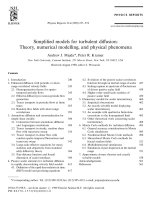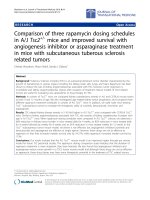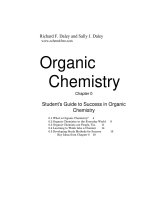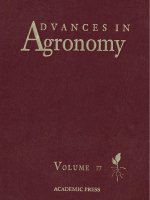(Advances in heterocyclic chemistry 6) a r katritzky and a j boulton (eds ) advances in heterocyclic chemistry academic press (1966)
Bạn đang xem bản rút gọn của tài liệu. Xem và tải ngay bản đầy đủ của tài liệu tại đây (19.33 MB, 485 trang )
Advances in
Heterocyclic
Cliemistry
Volume 6
www.pdfgrip.com
Editorial Advisory Board
A. Albert
A. T. Balaban
G. Fodor
S. Gronowitz
J. Gut
R. Huisgen
N.K. Kochetkov
J. H. Ridd
www.pdfgrip.com
Advances in
HETEROCYCLIC
CHEMISTRY
Edited by
A. R. KATRITZKY
School of Chemical Sciences
University of East Anglia
No rw ich , England
A. J. BOULTON
University of East AnSIia
Norwich, England
Volume 6
Academic Press
-
New York and London
www.pdfgrip.com
-
1966
COPYRIGHT@ 1966 ACADEMIC
PRESS
INC.
ALL RIGHTS RESERVED.
NO PART OF THIS BOOK MAY B E REPRODUCED IN ANY FORM,
BY PHOTOSTAT, MICROFILM, OR ANY OTHER MEANS, WITHOUT
WRITTEN PERMISSION FROM THE PUBLISHERS.
ACADEMIC PRESS INC.
111 Fifth Avmue, New York, New York 10003
United Kingdom Edition published by
ACADEMIC PRESS INC. (LONDON) LTD.
Berkeley Square House, London W.l
LIBRARY OF
CONGRESSCATALOGCARD NUMBER:
62-13037
PRINTED IN THE UNITED STATES O F AMERICA
www.pdfgrip.com
Contributors
Numbers in parentheses indicate the pages on which the authors’ contributions
begin.
R. A. ABRAMOVITCH,
Chemistry Department, University of Saskatchewan, Saskatoon, Saskatchewan, Canada (229)
PAULS . ANDERSON,
Merck and Company, West Point, Pennsylvania
(45)
KARELB L ~ H AInstitute
,
of Organic Chemistry and Biochemistry,
Czechoslovak Academy of Sciences, Prague, Czechosloaakia ( 147)
OTAKARCERVINKA, Department of Organic Chemistry, Institute of
Chemical Technology, Prague, Czechoslovakia ( 147)
I. I . GRANDBERG,
Faculty of Chemistry, The M . V . Lomonosov University, Moscow, U.S.S.R. (347)
FRANCISJOHNSON,
Eastern Research Laboratory, The Dow Chemical
Company, Wayland, Massachusetts (95)
A. N . KOST,Faculty of Chemistry, The M . V . Lomonosov University,
Moscow, U.S.S.R. (347)
J . H . LISTER,Institute of Cancer Research, Royal Cancer Hospital,
London, England ( I )
ROBERT
E . LYLE,Department of Chemistry, University of New Hampshire, Durham, hTewHampshire (45)
R A M ~MADRO~ERO,
N
Departamen,to de Quimica, Orghnica Instituto de
Quimica “Alonso Barba” (C.S.Z.C.),
Madrid, Spain (95)
J . G. SAHA,Chemistry Bepartment, University of Saskatchewan,
Saskatoon, Saskatchewan, Canada (229)
www.pdfgrip.com
This Page Intentionally Left Blank
www.pdfgrip.com
Preface
The effect of substituents on benzenoid reactivity has been one of
the most extensively investigated branches of chemistry. The scattered data on pyrictine substitution are now assembled in a review by
R. A. Abramovitch and J. G. Saha which is as valuable for showing
what remains to be done as for what has been achieved. R. E. Lyle
and P. S. Anderson survey reactions of nitrogen heterocycles with
complex hydrides, and the heterocyclic chemistry of nitriles and
nitrilium sa,lts is covered by F. Johnson and R. Madrofiero.
Each of the remaining three chapters deals with a group of compounds: cyclic enamines (K. B k h a and 0. cervinka), pyrazoles
(A. N. Kost and I. I. Grandberg), and physicochemical aspects of
purines (J.H. Lister).
Suggestions are welcome for contributions to further volumes ;
they should be in the form of a short synopsis.
We thank the Editorial Board, the publishers, and the authors for
their cooperation.
A. R. KATRITZKY
A. J. BOULTON
Norwich, England
June, 1966
vii
www.pdfgrip.com
This Page Intentionally Left Blank
www.pdfgrip.com
Contents
CONTRIBUTORS.
PREFACE. .
.
.
.
.
CONTENTS O F VOLUMES 1-5
.
.
.
.
.
.
.
.
.
.
.
.
.
.
.
.
.
.
.
.
.
.
.
.
.
.
.
.
V
.
vii
,
xi
.
.
.
.
2
Physicochemical Aspects of the Chemistry of Purines
J. H. LISTER
I. Introduction .
. . . . . .
11. Molecular Structure of Piirines .
.
111. Nucleophilic and Electrophilie Sulistitution
.
.
.
.
.
.
.
.
.
.
.
.
1
11
The Reduction of Nitrogen Heterocycles with Complex
Metal Hydrides
ROBERT
E. LYLEand P A ~S.~ANDERSON
L
I. Mechanism .
. . . . . . . . . . .
11. Reductions of Pyridinex and Pyridinium Ions
. . . .
111. Complex Metal Hydride Reduction of Isoquinolines and Isoquino. . . . . . . . . . .
linium Ions .
IV. Complex Metal Hydride Reduction of Quinolines and Quinolinium
Salts
. . . . . . . . . . . . .
V. Reduction of Non-aromatic Het.erocyc1e.s Conhining the C = N
Function
. . . . . . . . . . . .
VI. Reductions of Other Het,erocyclesContaining One Nitrogen Atom
VII. Reduction of Het,erocyclesContaining Two Nitrogen Atoms
.
VIII. Reductions of Azoles .
. . . . . . . . .
IX. Reduction of Heterocycles C'ontaining Three Nitrogen Atoms
.
X. Reduction of Pteridines with Complex Met,al Hydrides .
. .
XI. Summary
. . . . . . . . . . . .
46
55
68
73
75
77
80
86
89
91
93
Heterocyclic Syntheses Involving Nitrilium Salts and Nitriles
under Acidic Conditions
FRANCIS
JOHNSON
and R A M ~MNA D R O ~ E R O
I. Introduction .
.
.
. . . . . . .
11. Ring Formation Involving it Mononitrile Component .
111. Ring Formation Involving Cyclization of an (x.w - Dinitrile
ix
www.pdfgrip.com
.
.
.
.
. .
95
96
128
X
CONTENTS
Cyclic Enamines and Imines
KAREL
BLAHAand OTAKAR~ E R V I N K A
. Introduction . . . . . . . . . . . .
. Structure and Physicochemical Properties . . . . .
. Preparation of Enamines . . . . . . . . .
I
I1
I11
IV .
.
Reactions of Enamines
.
.
.
.
.
.
.
.
147
148
166
182
.
.
.
.
.
.
.
.
.
.
.
.
229
230
236
274
320
333
Substitution in the Pyridine Series : Effect of Substituents
R . A . ABRAMOVITCH
and J . G. SAHA
.
I Introduction-Scopeand Limibtions
I1. Theoretical Considerations
. .
I11. Electrophilic Substitution .
. .
IV. Nucleophilic Substitution .
. .
V Homolytic Substitution
. . .
VI Intramolecular Cyclizations
. .
.
.
.
.
.
.
.
.
.
.
.
.
.
.
.
.
.
.
.
.
.
.
.
.
.
.
Progress in Pyrazole Chemistry
A. N. KOSTand I . I . GRANDBERG
.
.
.
I Introduction .
. . . . . .
I1 The General Character of Pyrazoles .
.
I11 The Synthesis of Pyrazoles .
. . .
IV . Chemical Properties of the Pyrazole Nucleus
AUTHOR
INDEX
SUBJECT
INDEX
.
.
.
.
.
.
.
.
.
.
.
.
.
.
www.pdfgrip.com
.
.
.
.
.
.
.
.
.
.
.
.
.
.
.
.
.
.
.
.
.
.
.
.
.
.
.
.
.
.
347
350
358
389
431
463
Contents of Volume
1
Recent Advances in the Chemistry of Thiophenes
SALO
GRONOWITZ
Reactions of Acetylenecarboxylic Acids and Their Esters with
Nitrogen-Containing Heterocyclic Compounds
R. M. ACHESON
Heterocyclic Pseudo Bases
DENESBEKE
Aza Analogs of Pyrimidine and Purine Bases of Nucleic Acids
J. GUT
Quinazolines
W. L. F. ARMAREGO
Prototropic Tautomerism of Heteroaromatic Compounds: I. General
Discussion and Methods of Study
A. R. KATRITZKY
AND J. M. LAGOWSKI
Prototropic Tautomerism of Heteroaromatic Compounds ; 11. SixMembered Rings
A. R. KATRITZKY
A N D J. M. LAGOWSKI
xi
www.pdfgrip.com
Contents of Volume
2
Prototropic Tautomerism of Heteroaromatic Compounds : 111. FiveMembered Rings and One Hetero Atom
A. R. KATRITZKY
AND J. M. LAGOWSKI
Prototropic Tautomerism of Heteroaromatic Compounds : IV. FiveMembered Rings with Two or More Hetero Atoms
A. R. KATRITZKY
AND J. M. LAGOWSKI
Three-Membered Rings with Two Hetero Atoms
ERNSTSCHMITZ
Free-Radical Substitutions of Heteroaromatic Compounds
R. 0. C. NORMAN
AND G. K. RADDA
The Action of Metal Catalysts on Pyridines
G. M. B.4DGER A N D w. H. F. S A S S E
Recent Advances in Quinoxaline Chemistry
G. W. H. CHEESEMAN
The Reactions of Diazomethane with Heterocyclic Compounds
RUDOLFGOMPPER
The Acid-Catalyzed Polymerization of Pyrroles and Indoles
G . F. SMITH
1,3-Oxazine Derivatives
Z. ECKSTEIN
AND T. U R B A ~ ~ S K I
The Present State of Selenazole Chemistry
E. BULKA
Recent Developments in Isoxazole Chemistry
N. K. KOCHETKOV
AND S. D. SOKOLOV
xii
www.pdfgrip.com
Contents of Volume
3
The Quaternization of Heterocyclic Compounds
G. F, DUFFIN
The Reactions of Heterocyclic Compounds with Carbenes
C. W. REESA N D C. E. SWITHEN
The Carbolines
R . A. AB R S MOVIT CH
AND I A N
n. S P E N S E R
Applications of the Hammett Equation t o Heterocyclic Compounds
H. H. J A F F
A N~
D H . LLOYD
JONES
1,2,3,4-Thiatriazoles
K. A. JENSEN
AND C. PEDERSEN
Nucleophilic Heteroaromatir Substitution
G. ILLUMINATI
Pen tazoles
IVAR
UGI
...
XI11
www.pdfgrip.com
Contents of Volume
4
Covalent Hydration in Nitrogen-Containing Heteroaromatic Compounds : I. Qualitative Aspects
ADRIENALBERTAND W. L. F. ARMAREGO
Covalent Hydration in Nitrogen Heteroaromatic Compounds: 11.
Quantative Aspects
D. D. PERRIN
Recent Advances in Oxazolone Chemistry
ROBERT
FILLER
Isothiazoles
R . SLACK
AND K. R. H. WOOLDRIDOE
Hetarynes
H. J. DEN HERTOG
AND H. C. VAN
DER
PLAS
Reactivity of Azine, Benzoazine, and Azinzoazine Derivatives with
Simple Nucleophiles
ROBERT
G. SHEPHERD
AND JAMES
L. FEDRICK
xiv
www.pdfgrip.com
Contents of Volume
5
Electronic Structure of Heterocyclic Sulfur Compounds
R.ZAHRADNfK
Theoretical Studies of Yhysiro-chemical Properties and Reactivity
of Azines
R.Z A H R A D N i K A N D 3. KOCTECK+
1,2,CThiadiazoles
FREDERICK KVRZER
The Aminochromes
R. A. HEACOCK
Aromatic Quinolizines
B. S. THYAGARAJAN
Advances in Pyrrolizidine Chemistry
N. K . KOCHETKOV
.4ND -4.
M. h K H O S H E R S T O V
xv
www.pdfgrip.com
This Page Intentionally Left Blank
www.pdfgrip.com
Physicochemical Aspects of the Chemistry of Purines
J. H. LISTER
Institute of Cancer Research, Royal Cancer Hospital,
London, England
I. Introduction
. . . . . . . . . . . . . .
11. Molecular Structure of Purines
. . . . . . . . .
A. Electron Distribution . . . . . . . . . . .
B. Structural Features Derived from Spectroscopic Studies .
C. Structural Features Derived from Crystallographic Studies
111. Nucleophilic and Electrophilic Substitution . . . . . .
1
2
2
3
9
11
I. Introduction
The past decade has seen the synthesis of many hundreds of purines
and their analogs, the majority of which are the results of research
programs whose aim was the production of new chemotherapeutic
agents for use against neoplastic diseases. This same period also
witnessed the elucidation of the fine details of the basic structure of
the nucleic acids in which virtually the whole purine content was
found to be composed of adenine and guanine. From these studies, in
both the natural and synthetic fields, have emerged much data on the
physicochemical nature of these bases. It is the purpose of this review
to attempt to show how some of this knowledge may be used to explain
some reactions in purine chemistry in fairly general terms of the
activated sites and ionization states of the molecules. However, the
present state of knowledge is such,that all factors concerned in any
one reaction may not be fully appreciated and this is seen in the
apparent exceptions which are found to the general rules.
Other reviews are available dealing with specialized purine topics,
which include their general chemistry, synthesis from pyrimidines2
and i m i d a ~ o l e s biological
,~
synthesis, and nucleoside chemistry.
1
G . A. Howard, in “Chemistry of Carbon Compounds” (E. H. Rodd, ed.),
Vol. IVc, Chapter 20. Elsevier, Amsterdam, 1960.
2 J. H. Lister, Rev. Pure App2. Chem. 11, 178 (1961).
3 J. H. Lister, Rev. Pure Appl. Chem. 13, 30 (1963).
4 J. M. Buchanan, Harvey Lecture8 54, 104 (1960).
5 J. A. Montgomery and H. J. Hewson, Advan. Carbohydrate Chem. 17, 301
(1962).
1
www.pdfgrip.com
2
J. H. LISTER
[Sec. 11. A.
11. Molecular Structure of Purines
A. ELECTRON
DISTRIBUTION
Because of its historical association, the original ring numbering (1)
adopted by Fischere is still used in preference to that of the Ring
Index,? standard for purine analogs, which designates purine as
9- (or 7 -)H-imidazo(4,5-d)pyrimidine.
In considering the nature of the ring system, the properties of the
component parts must be taken into account. For this purpose purine
can be assumed to be derived by fusion of a pyrimidine and an
imidazole ring such that carbon atoms at the 4- and 5-positions of
each ring are common to both. Because of the competition of the two
doubly bonded nitrogen atoms for the .rr-electrons, pyrimidine is an
example of a 7r-electron-deficient system ; imidazole, on the other
hand, in having both a doubly and singly bonded nitrogen atom, is
representative of a 7r-electron-excessivesystem. As a consequence, the
electron distribution in purine is a result of the two effects, with the
pyrimidine ring having a share of the imidazole electrons. One
consequence of the partial localization of the electron distribution is
the establishment of dipoles which are usually resolved along the long
and short axes of the molecule. Purine is claimed8to be long axis major
polarized, but the introduction of strong electron-releasing or -withdrawing groups can modify or reverse the direction of the dipole effect.
One schooleasserts that 9-methyladenine shows its major dipole effect
along the short axis, a situation which crystallographic evidence
indicates may also exist with 1,3,7,9-tetramethyluric acid, although
the related purines, theophylline and caffeine, show long axis major
polarization.lo Theoretical treatment, using Pariser-Parr selfE. Fischer, Ber. Deut. C h m . Geu. 30, 557 (1897).
“The Ring Index,” 2nd ed. Am. Chem. Soc., Washington, D.C., 1960.
8 S. F. Mason, J. Chem. Soc. 1954,2071.
9 R. F. Stewart and N. Davidson, J. Chew. Phye. 39, 255 (1963).
lop. de Santis, E. Giglio, and A. M. Liquori, Naiure 188, 46 (1960).
8
7
www.pdfgrip.com
Sec. 11. B.]
PHYSICOCHEMICAL ASPECTS OF PURINES
3
consistent approximations, l1 predicts that adenine, like its 9-methyl
derivative, is major polarized along the shorter axis. The resultant
effect of the dipoles spectroscopically is to give rise to a broad main
band, the x-band, in the 230-280 mp region of the ultraviolet absorption spectrum. As yet, the two individual components which make up
this band cannot be attributed to the appropriate dipole until the
direction of the major dipole in the molecule has been determined.
With some simple purines a further narrow band, the y-band,8 around
the 220 mp region, is observed, but this was, until recently, outside the
range of standard instruments and it aa yet has provided no useful
data on purine structures.
B. STRUCTURAL
FEATURES
DERIVED
FROM SPECTROSCOPIC
STUDIES
Spectroscopy, in both the ultraviolet and the infrared, and also the
more recent nuclear magnetic resonance form, has been a useful tool
in deciding structural configuration. The part played by infrared is
self-evident, being used mainly to establish the presence or absence of
functional groups. The infrared spectra of heterocycles including
purines have been extensively reviewed.12 Ultraviolet absorption
spectroscopy, on the other hand, is less definitive in application but
two features of purine structure have been studied by means of it.
Variations in the spectrum with pH changes enable calculations of the
basic and acidic dissociation constants to be made, from which the
sites of proton capture or loss may be ascertained, whereas in cases
where 0x0-enol or amine-imine tautomerism is possible, the major
component present may be determined by comparison with analogs
in which the mobile hydrogen has been replaced by a methyl group.
Studies of tautomerism, in which the spectra of aminopurines and
their substituted-amino analogs were compared, show clearly that the
amino and not the imino form predominates.* Confirmation has been
supplied by infrared13and by nuclear magnetic resonance studies on
adenosine and g~anosine.l**’~
Alkylation of the pyrimidine ring nitroBerthod and A. Pullman, Compt. Rend. 257,2738 (1963).
R. Katritzky and A. P. Ambler, i n “Physical Methods in Heterocyclic
Chemistry” (A. R. Katritzky, ed.), Vol. 11, Chapter 10. Academic Press,
New York, 1963.
13 B. C. Pal and C. A. Horton, J . Chem. Soc. 1964,400.
14 J. P. Kokko, J. H. Goldstein, and L. Mandell, J . Am. Chem. SOC.
83, 2909
(1961).
15 H. T. Miles, F. B. Howard, and J. Frazier, Science 142, 1458 (1963).
11 H.
12 A.
www.pdfgrip.com
4
[Sec. 11. B.
J. H. LISTER
gens in adenine gives the corresponding 1- and 3-N-alkyladenines,
which on valence considerations can both be depicted in the 6-imino
(2a, 3a) or 6-amino forms (2b, 3b). Physical evidence shows that
whereas 1-methyladenine is present as the imino structure (2a,
R = Me)le the absence of an ionizable hydrogen in 3-methyladenine
is presumed to indicate the presence of the amino isomer (3b,
R = Me).13
NH
It
I
H
Generally speaking, the foregoing considerations cannot be applied
to the spectra of the oxopurines as a means of deciding which tautomeric modification is present. The curves are usually simple in form,17
although cases exist where sufficient points of difference between the
spectrum of an oxopurine and the corresponding methoxyl derivative
lead one to presume that the 0x0 form8.18is the one present. Unfortunately, this evidence, by itself, is unreliable, as the spectrum of
6-methoxypurine (4)) a molecule of the enol type, is very similar to
that of 1-methylhypoxanthine (5), the isomeric 0x0 derivative.Is A
likeness of this kind can be explained in terms of simplicity of
molecular structure giving rise to single peak spectra falling, coincidentally, at the same wavelength.8 The main evidence that the 0x0
form predominates in oxopurines comes from infrared measurements
made in the solid statel9 and in deuterium oxide sol~tion.'~
16
P. Brookes and P. D. Lawley, J . Chem. SOC.
1960,539.
D. 3. Brown a n d S. F. Mason, J . Chem. SOC.
1957, 682.
l8 G. B. Elion, Ciba Pound. Symp., Chem. Biol. Purines p . 39 (1957).
l9 S. F. Mason, Ciba Found. Syrnp. Chern. Biol. Purines p. 60 (1957).
17
www.pdfgrip.com
Sec. 11. B.]
PHYSICOCHEMICAL ASPECTS OF PURINES
0
H
(4)
(5)
I
H
The analogous purinethiones and their #-methyl derivatives,
however, afford better spectral differences between their tautomeric
forms than do the oxopurines. Evidence, taken from both u l t r a ~ i o l e t ~ ~
and infraredYz0
supports the view that in 2-, and 6-, and 8-thiopurines
the thione form predominates. A studyz1in which the spectra of oxopurines are compared with the corresponding thione and in certain
cases seleno derivatives shows that these heteroatoms are doubly
bound to the ring carbon atom and that their influence on the spectrum
is not uniform and varies with the position in the ring. Thus, replacement of the oxygen of a 6-oxopurine successively by sulfur and then
selenium produces a bathochromic shift, whereas on repeating the
process with a 2-oxopurine no such change is observed. It is proposed
that these effects may be related to the fact that a t the 6-position the
adjacent atoms form part of an “amidic” system, i.e.,
-NH-CS-
I
C=,
whereas a t the 2- and 8-positions the adjacent atoms are nitrogen, and
exists.
a “uridic ” structure, i.e., -NH-CS-N(H)-,
Spectral changes associated with pH variation, observed with
2-fluoropurine-6-thione, have been claimedzz to demonstrate the
existence of a thiol-thione tautomerism. Thus, whereas alkaline
solutions showed a thione-type spectrum, rather than the expected
anionic form, on acidification a change, which took place a t measurable
rate, to the thiol form spectrum occurred. This effect has been
attributed, by the authors, to the strong negative induction (-I)
character of the 2-fluoro atom rendering the sulfur atom more electronegative than the I-nitrogen. Consequently, in acid solution the
20
21
22
C. H. Willets, J. C. Decius, K. L. Dille, and B. E. Christensen, J. Am. Chern.
SOC.77,2569 (1955).
H. G. Mautner and G. Bergson, Acta Chem. Scand. 17,1694 (1963).
J. A. Montgomery and K. Hewson, J. A m . Chern. SOC.82,463 (1960).
www.pdfgrip.com
6
J. H. LISTER
[Sec. 11. B.
former behaves abnormally and becomes the site of protonation. As
proton capture is instantaneous, not time-dependent, a more logical
explanation might lie either in protonation of a carbon atom or ring
opening and recyclization occurring. Both of these are measurable rate
reactions. The possibility of covalent hydration also exists, but the
evidence for this occurring in purines is at present rather restricted.22a
In simple purines the imidazole ring is usually involved in anion
formation. The strong resemblance shown between the spectrum of
the anion ( 6 ) of 8-oxopurine and that of 7-methyl-8-oxopurine (7)
leads to the conclusion that dissociation a t the %nitrogen has
occurred.l7 Evidence along these lines is obtained from comparisons
of the alkaline spectra of 2- and 8-oxopurines with those of 2- and
8-aminopurines in neutral solution. The lack of correspondence
between the spectra of the 0x0 and amino derivatives has been cited
t~ an indication that ionization is probably associated with the fivemembered ring.8 The converse appears to be true for hypoxanthine,
the anionic spectrum of which is similar to that of the neutral molecule
of adenine. Supporting evidence23suggests that dissociation gives rise
to the same hydrogen-bonded anion (8)) and the possibility that
adenine may also form this type of internally bonded derivative would
explain the spectral similarity. Attempts to resolve the site of proton
loss in hypoxanthine have been made using the acid-strengthening
properties produced by the insertion of fluorine atoms. Both the
2-trifluoromethyl- ( 9 ) and 8-trifluoromethylhypoxanthines(10) were
22a
A. Albert, Personal communication (1963).
Albert, Biochm. J . 54,646 (1964).
23 A.
www.pdfgrip.com
Sec. 11. B.]
PHYSICOCHEMICAL ASPECTS OF PURINES
7
examined in the hope that the derivative having the fluorine-containing group nearest t o the ionization center would show the greatest
lowering of the anionic dissociation constant. In practice, both
derivatives showed a similar, and therefore inconclusive, decrease in
value. 24 Studies on the spectra of methylated hypoxanthine derivatives have also failed to settle the point, the proton being lost with
equal facility from the imidazole ring or the pyrimidine ring ; ionization, therefore, is considered t o be a function of the molecule as a whole
rather than to be associated with a particular atom or
H
(9)
(10)
With di- and trioxopurines ionization is possible in either ring and
can occur at more than one site in the molecule. Xanthine (2,6-dioxopurine) suffers first proton loss at the 3-position, this also being the
case for its 1-methyl, 7-methyl, and 1,7-dimethyl derivatives.20With
increasing pH values the dianion is formed by loss of a proton from the
7-position, and finally the 1 -position is deprotonated. If Che 3-position
is already substituted, as in 3-methyl- and 1,3-dimethyl-xanthine,
then the 7-nitrogen loses the first proton. Investigations of this type
on uric acid (2,6,8-tnoxopurine) and its derivatives show that the
imidazole ring contains the most readily ionized hydrogen on the
g - n i t r ~ g e nwith
, ~ ~ second and third centers at the 3- and 1-positions,
respectively.
One observation resulting from this work has been that ionization
A. Giner-Sorolla.and A. Bendich, J . Am. Chem. SOC.
80,5744 (1958).
G. B. Elion, J . Org. Chem. 27, 2478 (1962).
26 L. F. Cavalieri, J. J. Fox, A. Stone, and N. Chang, J . Am. Chem. SOC.
76,
24
25
1119 (1954).
27
F. Bergmann and S. Dikstein, J . Am. Chem. SOC.77, 691 (1955).
www.pdfgrip.com
8
[Sec. 11. B.
J. H. LISTER
and methylation of xanthine and uric acid derivatives produce similar
spectral effects,27 an effect not unexpected, considering that removal
of a proton or insertion of a methyl group will enhance the electron
density of the associated nitrogen atom. The two types of spectra,
although not necessarily alike in intensity, show wavelength changes
of the same order. Thus the hypsochromic shift noted between a
purine and its 1-methyl derivative is comparable with that seen when
the purine undergoes proton loss at the 1-position. If ionization or
alkylation occurs at any of the other nitrogen atoms, a bathochromic
shift is observed. The fluorescence which is produced in solutions of
guanosine and adenosinez8 at certain pH values is similar t o that
displayed by neutral solutions of corresponding methylated nucleosidesz9 and correlations between sites of alkylation and ionization
have been drawn.
Cation formation through proton addition can occur at various
sites. Purine and its simple derivatives protonate in the pyrimidine
ring.30,31 Adenine, on the basis of results of studies on metal complex
formation, is claimed to have the most basic nitrogen in the 6-amino
showing that the
group,32 but this conflicts with other
pyrimidine ring is the preferred center for protonation as in other
6-substituted purines.33 Simple adenine derivatives form the cation
by proton addition at the 1-position, as do the 9-ribosyl analogs,l“ but
A
the 3-position is sometimes preferred, as in 2,6-diaminop~rine.~~~
comparison of the ionization constants of 2- and 6-methylmercaptopurine shows N-1 to be the most basic nitrogen,31 the cation being
stabilized through resonance forms, cf. l l a and l l b . Guanine, unlike
I
-
H-N
4x2
\
I
H
H
(1W
(1la)
H. C. Borresen, Acta Chem. Scand. 17, 921 (1963).
H. C. Borresen, Acta Chem. Scand. 17,2359 (1963).
30A. Bendich, P. Russell, and J. J. Fox, J . Am. Chem. SOC.76, 7063 (1954).
31 A. Albert, in “Physical Methods in Heterocyclic Chemistry’’ (A. R.
Katritzky, ed.), Vol. I, Chapter 1. Academic Press, New York, 1963.
32 G . E. Cheney, H. Freiser, and Q. Fernando, J . Am. Chem. SOC.81, 2611
(1959).
33 A. Giner-Sorolla and A. Bendich, J . A m . Chem. SOC.
80, 3932 (1958).
330 A. Veillard and B. Pullman, J. Themet. Biol. 4, 37 (1963).
28
29
www.pdfgrip.com









